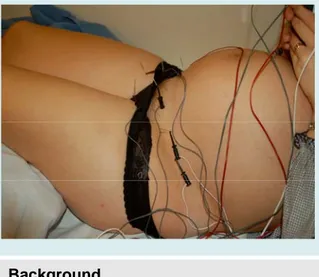http://www.diva-portal.org
Postprint
This is the accepted version of a paper presented at SFOG-veckan 2014.
Citation for the original published paper:
Vixner, L. (2014)
Acupuncture with manual and electrical stimulation for labour pain: A longitudinal randomised
controlled trial.
In:
N.B. When citing this work, cite the original published paper.
Permanent link to this version:
Acupuncture with manual and electrical stimulation for
labour pain: A longitudinal randomised controlled trial
Linda Vixner (1,2) Erica Schytt (1,3) Elisabet Stener-Victorin (4) Ulla Waldenström (1) Hans Pettersson (5) Lena Mårtensson (6) 1: Karolinska Institutet, 2: Dalarna University, 3: Centre for Clinical Research Dalarna, 4: University of Gothenburg, 5: Karolinska Institutet, Södersjukhuset, 6: University of Skövde.Conclusion
Acupuncture does not reduce women’s experience of labour pain,
however, women receiving a combination of manual and
electro-acupuncture (EA) used less additional pain relief, including epidural
analgesia, and had shorter labour than women in the standard care
group (SC). Despite the lower use of other pain relief, a majority of the
women who used EA were equally satisfied with their pain relief as
the women receiving manual acupuncture alone (MA) or SC. They
were also equally satisfied with the support from the midwife.
Results
Background
Acupuncture using manual stimulation (MA) of the needles is commonly used to reduce labour pain despite contradictory results from studies of its effectiveness. A combination of manual and electrical stimulation (EA) could reduce labour pain more effectively than MA alone, by a higher treatment intensity.
Methods
Nulliparous women (n=303) with a normal pregnancy were equally randomized to three groups receiving 40 minutes of either MA, EA or to SC.
The primary outcome was women’s assessment of labour pain; before and after the first treatment, every 30 minutes for five hours, and thereafter every hour until birth, or until epidural analgesia was administered.
For the primary outcome, a linear mixed model for repeated measures was performed to investigate associations between treatment (MA, EA, SC) and pain scores on VAS over time. A difference of 15 mm on the visual analogue scale (VAS) was regarded as clinically relevant, and this required 41 women per group, and compensating for dropouts, in total 101 women in each group.
Data on the primary outcome were obtained from 253 women: MA n=83, EA n=87, and SC n=83.
Karolinska Institutet Linda Vixner
Physiotherapist, Doctoral student Linda.vixner@ki.se
Vixner et al. Acupuncture with manual and
electrical stimulation for labour pain: a longitudinal randomised controlled trial. BMC Complementary and Alternative Medicine 2014, 14:187 doi:10.1186/1472-6882-14-187
Figure 1. Mean estimated pain scores during labour
MA= Manual acupuncture, EA= combination manual and electro-acupuncture, SC= Standard Care. VAS=Visual Analogue Scale. After time interval 6, n < 41 in MA and EA. After time interval 8, n < 41 in SC
Aim and Hypotheses
The aim was to evaluate the effectiveness of MA and EA compared with standard care without any acupuncture (SC) in reducing labour pain. Our hypothesis was that both acupuncture stimulation techniques were more effective than SC, and that EA was the most effective.
Mean estimated pain scores on VAS
MA: 66.4, EA: 68.5 and SC: 69.0 (Figure 1).
SC vs MA: mean difference 2.6, 95% confidence interval (CI) -1.7-6.9. SC vs EA: mean difference 0.6 (95% CI) -3.6-4.8.
Secondary outcomes
Use of epidural analgesia: MA 61%, EA 46%, SC 70%.
EA vs SC: odds ratio (OR) 0.35; (95% CI) 0.19-0.67. EA vs MA: OR 0.57 (95% CI) 0.31-1.06.
Duration of labour (min): MA 619, EA 500, SC 615.
EA vs SC: Hazard Ratio (HR) 1.44; (95% CI) 1.06-1.97. EA vs MA: HR 1.41; (95% CI) 1.03-1.91.
Sufficient pain relief: MA 77%, EA 81%, SC 74% (ns).
Positive experience of the midwife:MA 100%, EA 97.5%, and SC 98.7% (ns).
